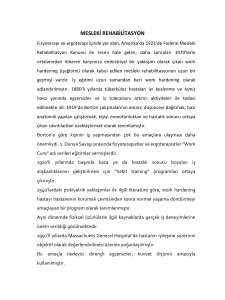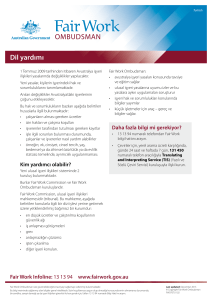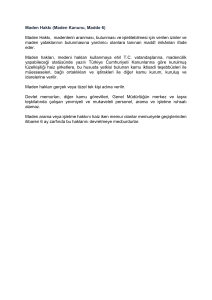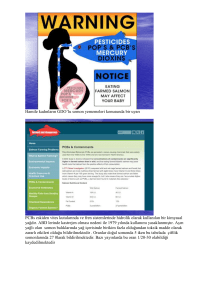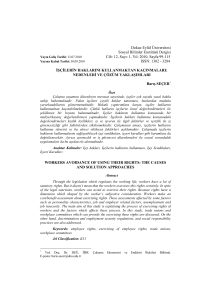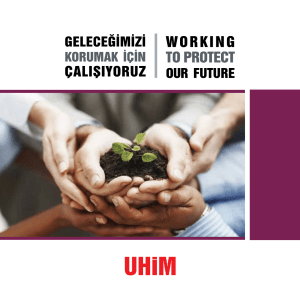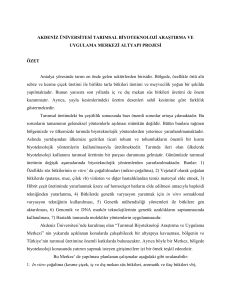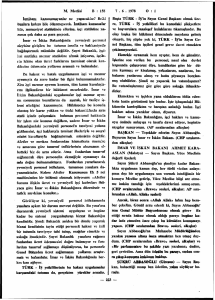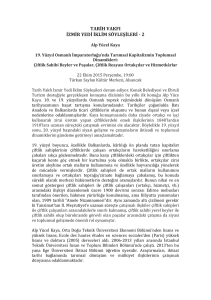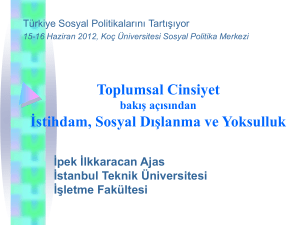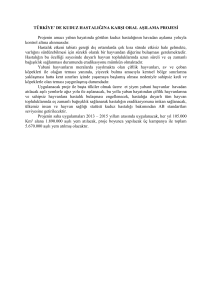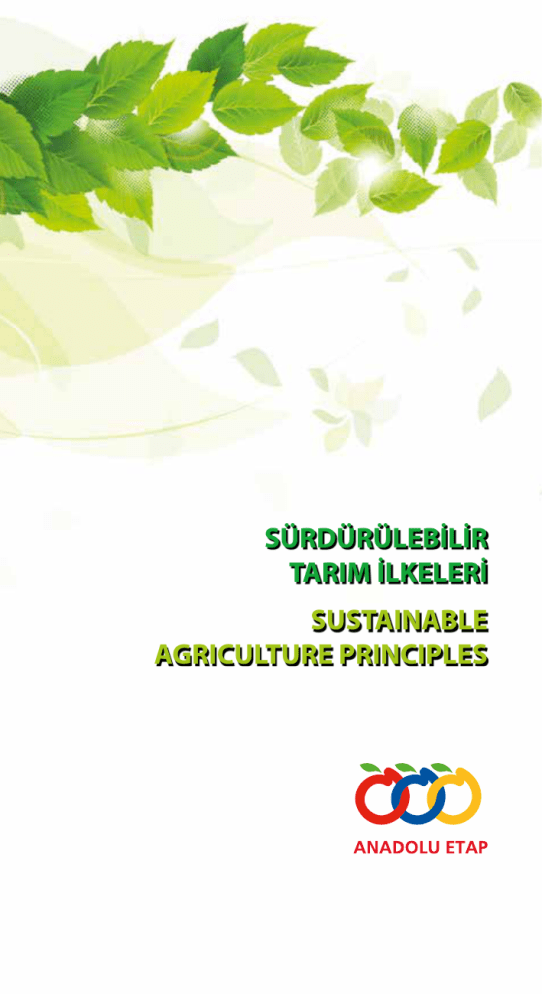
SÜRDÜRÜLEBİLİR
TARIM İLKELERİ
SUSTAINABLE
AGRICULTURE PRINCIPLES
1
ANADOLU ETAP
AEP Anadolu Etap Penkon Gıda ve Tarım Ürünleri Sanayi ve
Ticaret A.Ş. 2009 yılı sonunda Anadolu Grubu, Özgörkey Holding
ve Brezilyalı Cutrale Grubu işbirliği ile meyvecilik ve meyve suyu
sektöründe entegre operasyonları ile global bir tedarikçi olma
hedefiyle kurulmuştur.
Kendi tesislerinde oluşan yüksek kaliteli hammadde ihtiyacını ve
taze meyve sektöründeki talebi karşılamak amacıyla 2010 yılında
plantasyon yatırımlarına başlamıştır. Ağustos 2014 itibariyle beş
farklı bölgede 24.000 dekar alanda kurulu altı çiftliğinde 2,5 milyon
dikili meyve ağacının sahibidir. Anadolu Etap 2020 yılında 50.000
- 60.000 dekar arazi üzerinde 10 milyon meyve ağacına ulaşmayı
hedeflemektedir.
Kuruluşundan bu yana geçen sürede Mersin ve Denizli’de bulunan fabrikalarıyla Türkiye’de en yüksek meyve işleme kapasitesine ulaşmıştır ve Amerika’dan Japonya’ya kadar kesintisiz hizmet
vermektedir.
ANADOLU ETAP
AEP Anadolu Etap Penkon Gıda ve Tarım Ürünleri Sanayi ve Ticaret A.Ş.
established in 2009 by Anadolu Group, Özgörkey Holding and Cutrale
Group of Brasil envisioning to become a leading global supplier of fruit
juice concentrate and marketer of high quality fresh fruits through vertically integrated operations.
Anadolu Etap started establishing its own large scale fruit farms in 2010
in order to meet the demand for high quality raw material and
fresh market. Anadolu Etap who owns the largest fruit
production operations in Turkey as of August 2014
have established 2.400 hectares of farm and 2,5
million trees have been planted. Anadolu Etap
aims to reach 5.000-6.000 hectars of farm
and 10 millions of trees until 2020.
Since its establishment with the processing facilities located in Mersin and
Denizli Anadolu Etap reached the highest fruit processing capacity in Turkey
and continuously serves for its customers from Americas to Japan.
3
ÖNSÖZ
Türkiye’nin en büyük meyvecilik ve meyve suyu üretimi projesini
gerçekleştirmek üzere çıktığımız yolda, insan ile doğa arasında
dengeyi muhafaza ederek doğal kaynakları tüketmeden, gelecek nesillerin ihtiyaçlarının karşılanmasına ve bölgesel kalkınmaya imkan verecek şekilde yaşamı korumaya çalışıyoruz. İyi
Tarım Uygulamaları ve GLOBALG.A.P. standartlarında üretimimizle
sürdürülebilirlik üzerine konuşmaktan daha fazlasını yapıyoruz.
Dünyadaki gelişmeleri yakından takip ediyor, kıyaslama yaparak
yenilikçi yaklaşımla mevcut uygulamalarda iyileştirme yapıyoruz.
Bu amaçla ilkelerimizi belirli periyodlarla inceliyor, gerekli görülmesi durumunda revize ediyoruz.
Faaliyetlerimizin bütününde sosyal, ekonomik ve çevresel sürdürülebilirliği en önemli değerimiz olarak belirginleştiriyor, gelecek
nesiller için sorumluluğumuzu tarıma ve tarıma dayalı endüstriye
yatırım yaparak, ekolojik dengeyi koruyarak ve “sağlıklı nesiller için
sağlıklı meyveler” sloganıyla çalışarak sürdürüyoruz. İlk fidanımızı
diktiğimiz 23 Nisan 2011’den bu yana geçen süre boyunca çiftliklerimizde uyguladığımız ilkelerimizi resmi kurumların, hissedarlarımızın, akademisyenlerin, çalışanlarımızın, tedarikçilerimizin ve
müşterilerimizin görüşünü alarak bir araya getirdik. Bugün kamuoyu ile paylaşıyor olduğumuz ilkelerimizi önümüzdeki dönemlerde de uygulamayı ve sürekli geliştirerek daha yüksek standartlara taşımayı taahhüt ediyoruz.
M. Demir ŞARMAN
Genel Müdür
4
FOREWORD
On the road to realize Turkey’s biggest fruit growing and fruit juice
project, we are trying to meet the needs of future generations by
protecting life, using natural resources, efficiently enabling regional
development in the same time and preserving the balance between
human beings and nature. By our production based on GLOBALG.A.P.
standards, we do more than talking about sustainability.
We follow closely the developments in the world, we compare them
and by an innovative approach, we improve in our existing practices.
For this purpose, we review our principles regularly and when necessary, we revise them.
We punctuate social, economic and environmental sustainability as
our most important value in our activities and we maintain our responsibility for future generations by investing in agriculture and agriculture based industry, preserving ecological balance and by our motto
“healthy fruits for healthy generations”. Since April 23, 2011 when we
planted our first sapling, to date, we have created our principals we
implement in our farms as per the point of view of public enterprises, our shareholders, academicians, our employees, our suppliers and
our customers. We undertake to implement in the future, our principles
which we hereby share with the public opinion.
M. Demir ŞARMAN
CEO/Managing Director
5
SOSYAL SÜRDÜRÜLEBİLİRLİK
A) Çalışan ve İşçi Hakları ile Çalışma Ortamı
1.Sözleşmeler
a.İş Sözleşmesi: Çalışanlar ile Anadolu Etap (AE) arasında
bir iş sözleşmesi imzalanır. Bu sözleşmede çalışanın yapacağı iş, alacağı ücret, çalışacağı gün ve saatler ile çalışma
şekli, sözleşmenin başlangıç tarihi ve süresi, sözleşmenin
özel şartları (yıllık ücretli izin vb.) ve sözleşmeden doğacak ihtilafların çözüm yolları yer alır. Sözleşmeye ek olarak
çalışan;
i. Anadolu Grubu (AG) Sosyal Medya Taahhütnamesi
ii. AG Çalışma İlkeleri Kitapçığı
iii. AE Temel Çalışma Politikaları
iv. AE Uygunsuzluk Yönetmeliği
v. İş Sağlığı ve İş Güvenliği Talimatı
vi. Sır Saklama Taahhütnamesi
vii.Diğer (Aile Durum Bildirimi Formu vb.) imzalar.
b.Mevsimlik Tarım İşi Sözleşmesi: Tarımda İş Aracılığı
Yönetmeliğine göre; aracılar ile AE arasında; aracı, gündelik yevmiyeli işçi ve işveren arasındaki üçlü ilişkiyi düzenleyen bir mevsimlik iş sözleşmesi imzalanır. Bu sözleşmede aracının ve gündelik yevmiyeli işçinin alacağı ücret
başta olmak üzere işverenin, aracının (işçi bulma yükümlülüğü, gündelik yevmiyeli işçilerin uygun araçlarla işyerine ulaşımının sağlanması), gündelik yevmiyeli işçilerin
yükümlülükleri ile İş Sağlığı Güvenliği (İSG) kuralları gibi
özel koşullar yer alır.
2. İşyeri Koşulları ve Çalışma Şartları
a. Yönetim, çalışanlarına ve gündelik yevmiyeli işçilerine
sağlıklı ve güvenli bir çalışma ortamı sağlar. Bu amaçla aşağıdaki uygulamalar yapılır;
i. Çalışanın ihtiyacı, pozisyonun gerektirmesi ve çiftliğin
imkânları dâhilinde, çalışanlara ücretsiz ve uygun özelliklere sahip bir konut sağlanır.
ii. Çiftliklerde yaşayan çalışanlar için barınma, beslenme
ve tıbbi tedavi sağlanır.
iii.Gıdaların hazırlanması, depolanması ve tüketimi için
uygun ve sağlıklı tesisler temin edilir.
6
SOCIAL SUSTAINABILITY
A)Employee, Employee Rights and Working Environment
1. Contracts
a.Work Contract: A work contract is signed between the
employee and Anadolu Etap (AE). In this contract, the employee’s job description, his wages, working days and hours,
together with the manner he/she is going to work, starting
date of the contract and its duration, special conditions (annual
paid leave, etc.) and the resolutions to dispute originating from
this contract, are given in detail. In addition to the contract, the
employee signs the following;
i. Anadolu Group (AG) Social Media Undertaking
ii. AG Work Principles Manual
iii. AE Basic Labour Policy
iv. AE Declaration of Nonconformity Policy
v. Occupational Health and Safety Instructions
vi. Letter of Undertaking to Secrecy
vii. Other (Form of Declaration of Family Status, etc.)
b.Contract for Seasonal Agricultural Work: According to
the Work Intermediary in Agriculture; signed between the
intermediary and AE; a work contract that regulates the relationship between the intermediary, per-diem employee and
the employer is signed. Special conditions, such as Employer’s
responsibilities (Wages, etc.), intermediary’s responsibilities (to
find employers, to provide appropriate service vehicles that
transport per-diem employees to the work place), per-diem
employee responsibilities, together with service vehicles, Occupational Health Safety (İSG) regulations are found in this contract.
2. Workplace and Working Conditions
a. Management provides for its workers and per-diem employees a healthy and safe working environment. For this purpose,
the following practices are applied;
i. If the workers need or if their position requires, the
management provides, free of charge, within its resources,
living quarters that have certain specific properties.
ii. The management provides housing, food and medical
treatment for its workers that live in the farms.
iii.The management provides adequate facilities for the
preparation, storage and consumption of food products,
in a healthy environment.
7
iv. Çiftliklerde çalışan tüm bireyler güvenli, temiz ve sağlıklı
bir işyerinde çalışmayı hak ederler. Çiftlik yönetimi bunu
sağlamakla yükümlüdür. Yönetim güvenli ve sağlıklı bir
işyeri sağlamak için tüm tedbirleri alarak, çalışanları ve
gündelik yevmiyeli işçileri teşvik eder.
v. Çalışanlara ve gündelik yevmiyeli işçilere, sağlıklı ve
hijyenik koşullarda, suyu olan tuvalet ve duş imkânları
sağlanır.
b. Çalışanlara ve gündelik yevmiyeli işçilere temiz içme suyu
sağlanır.
c. Çalışanların ve gündelik yevmiyeli işçilerin kullanabilecekleri yemek ve dinlenme alanları mevcuttur ve gerekli olduğu
durumlarda bu alanlara ulaşım sağlanır.
d. Yönetim, iş sağlığı ve güvenliği konusunda risk değerlendirmelerini yapar, gerekli tedbirlerin alınmasını, iyileştirmelerin
gerçekleştirilmesini, çalışanların bilinçlendirilmesi amacıyla
eğitim çalışmalarını organize eder.
e.Yönetim çalışanlarının yıllık tıbbi kontrol zamanlarını takip
eder; kontrol zamanlarında çalışanının sağlık kuruluşuna
gitmesini teşvik eder ve sonuçlarını izler.
f. AE İnsan Kaynakları Politikaları doğrultusunda; çalışanlardan bazıları İlk Yardım Eğitimi’ne gönderilir ve sertifika almaları sağlanır.
g.Çiftliklerde, arazi koşullarında karşılaşılabilecek acil durumlar için ilk yardım malzemelerinin yer aldığı ilk yardım dolabı
ve çantası bulunur. İlk yardım malzemelerinin yenilenmesi
amacıyla dolaplar ve çantalar periyodik aralıklarla kontrol
edilir.
h.Çalışanların ve gündelik yevmiyeli işçilerin yaptıkları işle
ilgili AE tarafından temin edilen koruyucu ekipmanı kullanmaları zorunludur. Tarımsal girdilerle çalışan tüm bireyler,
koruyucu kıyafet ve ekipman kullanırlar.
i. Tarımsal girdi hazırlama ve depolama yerleri ve varsa sulama
havuzu yakınlarındaki kolay ulaşılabilir yerlere vücut duşu
ve göz duşu yerleştirilmiştir. Bu alanlarda bulunan ikaz
levhaları, duş kullanma talimatları acil durumda duşların
nasıl kullanılacağını gösterir.
j. Çiftliklerde çalışanların ve gündelik yevmiyeli işçilerin çiftlik
içinde ulaşımları güvenli araçlarla gerçekleştirilir. Ulaşım için
römork, traktör vb. araçlar kullanılmaz. Gündelik yevmiyeli
işçilerin çiftliklere ulaşımları güvenli araçlarla gerçekleştirilir ve bununla ilgili bir madde, aracı ile imzalanan Mevsimlik
Tarım İşi Sözleşmesi’nde yer alır.
k. Çiftliklerde İş Sağlığı Güvenliği Uzmanı, İşyeri Hekimi, Diğer
Sağlık Personeli istihdam edilir veya danışmanlık hizmeti
alınır.
8
iv. All the individuals that work in the fields deserve a safe,
clean and healthy working environment. Farm management is responsible for providing these conditions. The
motivation of its workers and per-diem employees, by
taking all the necessary precautions to provide a safe and
healthy workplace, is of utmost importance.
v. Workers and per-diem employees have access to restrooms
with clean water, including showers in hygienic conditions.
b. The management provides fresh drinking water to its workers
and per-diem employees.
c. Provides spaces where workers and per-diem employees can
eat and have a break; when necessary, provides the means to
access these areas.
d. Management performs risk evaluations, regarding occupational
health and safety; sees to the taking of necessary precautions
and the implementation of improvements; organises studies for
training and to help improve its workers’ awareness.
e.The management closely follows its workers’ annual health
checks and monitors the results, creating incentives for their
participation.
f. In accordance with Human Resources Policy; some of the
workers are sent to First Aid training and are provided with a
certificate.
g.For possible emergency situations; a first aid cabinet and bag,
with indispensable equipment, is always present in the field,
in the case of eventual incidents that might occur. For the
purpose of renewal of first aid materials, cabinets and bags are
periodically controlled.
h.The use of personal protection equipment, adequate for the
specific work that the employees perform, is mandatory. All
individuals working with agricultural inputs must make use of
protective wear and equipment.
i. Eye wash and body showers are placed with an easy access, near
the irrigation pool, if there is any, together with agricultural input
preparation and storage places. Warning signs and shower use
instructions, situated in these places, provide necessary information for the correct use in any possible emergency situation.
j. Workers and per-diem employees that work in the field are
provided safe and sound means of transportation. Trailers, tractors and the like are not used for transportation purposes. The
transportation of workers and per-diem employees is carried
out with secure and proper vehicles and an article regarding
this matter is found in the Seasonal Agricultural Work contract
that is signed with the intermediary.
k.The management purchases the services of Occupational
Health and Safety Expert, Staff Physician and Other Health
Personnel to provide counseling at the farms.
9
3. Çalışma Saatleri ve Ücret
a. Çalışanların ücret ve yan ödemeleri, yasal mevzuatlarda
öngörülen asgari tutarda veya üzerinde belirlenir. Ücret
belirlenirken yapılan iş, performans, eğitim, tecrübe, beceri
ve yetkinlik göz önünde bulundurulur.
b. Bir iş günündeki çalışma ve dinlenme süreleri, yıllık ücretli
izin günleri, tatiller, hastalık izinleri ve diğer izinler aşağıdaki
koşulları içerir. Bu haklara ilişkin düzenlemelerin çalışanlar
tarafından bilinmesi sağlanır ve bunlara iş sözleşmesinde
yer verilir.
i. Haftalık normal çalışma süresi 45 saattir, bu saati aşan
çalışmalar için İş Kanunu’nun fazla çalışma hükümleri
uygulanır,
ii. Her aralıksız 6 iş gününe karşılık 1 gün hafta tatili verilir,
iii.Yıllık ücretli izin günleri, çalışanın kıdemine göre AE
Sosyal Yardım ve İzin Yönetmeliği’nde düzenlenmiştir
ve minimum 14 iş günüdür.
c.Fazla mesaide, çalışan veya gündelik yevmiyeli işçinin
gönüllülüğü esastır. Yoğun sezonda fazla çalışma yapılabilir ve yapılan her fazla çalışma, işverenin takdirine göre izin
kullanımı veya fazla çalışma ücreti şeklinde tazmin edilir.
d. Disiplin amaçlı olarak ücretlerden kesinti yapılmaz.
e.Yönetim istihdam karşılığı herhangi bir ödeme istemez,
böyle bir ödemeyi kabul etmez.
4. Ayrımcılığı Sonlandırmak
a.Ulusal ve uluslararası yasal düzenlemelerin eşitlikle ilgili
hükümleri uyarınca ayrımcılığın hiçbir türü kabul edilemez
ve AE ayrımcılığı destekleyen faaliyetlerde bulunmaz.
b. Yönetim, ayrımcılık olduğunu düşündürtecek her türlü yazılı
veya sözlü eylemden kaçınır.
c.Terfi, eğitim, tazminat, işten çıkarma, ücret ve emeklilik
konularında; yaş, cinsiyet, ırk, din, dil, etnik köken, cinsel
yönelim, inanç, medeni, sosyal veya ekonomik durum,
engellilik hali, politik görüş, sendikal faaliyetlere katılım ve
üyelik, hamilelik ya da askerlik hizmeti durumu açısından
ayrımcılık yapılmaz.
d. Yönetim çalışanın; performansı, kıdemi ve yetkinliğini gözeterek aynı işlerde çalışan kişilere hiçbir ayrım yapmaksızın
eşit ücret, eğitim, terfi ve ek hak imkânı sağlar.
e.‘Dezavantajlı insanlar’ için pozitif ayrımcılığı yasalarla
destekleyen önlemler dahilinde, pozitif ayrımcılığa izin verilir. AE’nin çalışanı iken özürlü duruma düşen çalışanlara, çiftliğin ‘dezavantajlı çalışan’ kontenjanı dahilinde öncelik tanınır.
10
3. Working Hours and Wages
a. Worker wages and supplementary payments are determined
according to the legal regulation at the minimum amount
or higher. When determining a wage, the work carried out,
performance, education, experience, skills and competence
are taken into consideration.
b. Daily working hours and break durations, the amount of annual
paid leave days, holidays, sickness leaves and other leaves
consist of the following conditions. Workers are informed
regarding these rights and they are mentioned in the work
contracts.
i. According to the law, weekly working hours are a total of
45 hours; for those that exceed this duration, further working provisions of the Labour Code are applied.
ii. For every 6 days of uninterrupted work, workers receive
one day off.
iii. Annual paid leave is regulated according to the worker’s
seniority by the AE Social Assistance and Leave Regulations and consists of 14 working days minimum.
c. Worker and per-diem employee’s willingness forms the basis in
working overtime. In busy seasons, it is possible that the workers are asked to work overtime and it is compensated at the
employer’s discretion, either as annual leave or overtime pay.
d.It is not possible to cut back on salaries for disciplinary
purposes.
e.Management does not demand a payment in return for
employment and will not expect any such attempt.
4. Terminating Discrimination
a. According to the National and International legislation’s
equality provisions, discrimination of any kind is inadmissible;
moreover, AE does not participate in any sort of activities that
support discrimination.
b. Management refrains from all written or spoken activities that
might give rise to the thought of discrimination.
c. On the subjects of promotion, training, indemnity, dismissal,
wages and retirement; no discrimination on the grounds of
ethnic groups, nationality, religion, sect, sex, sexual preference,
age, pregnancy, disability, worker’s unions, or political connections is tolerated.
d.Management provides the same wage, training, promotion
and additional rights, without any exception, regarding the
performance, seniority and competence of the workers that
work in the same field.
e.The management permits positive discrimination for “Disadvantaged People” within the right legislations that are supportive of positive discrimination.
11
f. Yönetim, çalışanlar ve gündelik yevmiyeli işçilerden, işle
ilgisi bulunmayan tıbbi kayıtlarını isteme hakkına sahip
değildir. Ancak yönetim, yasal alkol ve uyuşturucu testi
isteme hakkını saklı tutar.
5. Sendika Kurma ve Katılma Özgürlüğü
Tüm çalışanlar ve gündelik yevmiyeli işçiler, kendi istekleri
doğrultusunda sendika kurma ve katılma hakkına sahiptir. Bu
sendikalar, kendilerini temsil edecek kişileri seçme hakkına
sahiptirler. Seçilen temsilciler, yönetim ile gerçekleştirilen toplu
iş sözleşmelerinde işçileri temsil etme hakkına sahiptirler. İşçi
temsilcilerine ayrımcılık yapılmaz.
6. Çocuk İşçi ve Zorla İşçi Çalıştırma Yasağı
a. 15 yaşını doldurmamış kişiler, çalışan ya da gündelik yevmiyeli işçi olarak çalıştırılmaz.
b.18 yaşının altındaki genç gündelik yevmiyeli işçiler, kendi
sağlıklarını ve güvenliklerini tehlikeye atacak işlerde (daha
tehlikeli, emniyetsiz veya sağlıksız) çalıştırılmaz.
c. Her türlü zorla çalıştırma, insan kaçakçılığı, esir işçilik yollarıyla elde edilen iş gücü kabul edilmez ve desteklenmez.
Belirtilen şekillerle iş gücü sağlamak yasaktır.
d.Yasal izinleri bulunmayan yabancı uyruklu kişiler çalıştırılmaz.
e.Daimi olarak çiftliklerde yaşayan çocukların güvenliğini
sağlamak amacıyla; yetiştiricilik yapılan alanlar, sulama
havuzları, pompa binaları vb. ile diğer kullanım alanları
(lojman, yemekhane, çocuk oyun alanları gibi sosyal tesisler)
birbirinden ayrılmıştır ve çocukların bu alanlara geçişine izin
verilmez.
7. Şiddet ve Tacizin Önlenmesi
Yönetim, çiftlik alanları içinde veya işle ilgili alanlarda herhangi
fiziksel, cinsel, psikolojik, sözlü taciz, tehdit ve cezaya izin
vermez.
8. Sorunların Çözümü
Yönetim, bireylerin işle ilgili problem veya şikâyetlerini dile
getirebilecekleri ve yöneticilerine iletebilecekleri, iletişime
açık bir ortam sağlar. Bireylerden gelen şikâyet veya negatif
bildirimlere karşı tepkisel, baskılayıcı tavır ve tutumlara taviz
vermez. Bu problem veya şikâyetlerin çözümü konusunda
yönetim adil ve şeffaf davranır.
12
f. Management has no right to demand, from its workers and
per-diem employees, health records that are not related to
the work they are assigned to; however, reserves the right to
demand legal testing for drug and alcohol abuse.
5. Freedom of Association
All workers and employees have the right to form syndicates
in their own will and the freedom to participate in them. These
syndicates have the right to nominate an individual to represent
them. The nominated representative has the right to speak for the
employees in the collective labour contracts carried out with the
management. Worker representatives are not discriminated.
6. Child Labour and Forced Labour Prohibition
a.Individuals that have not completed their 15 years of age
cannot be employed as workers or per-diem employees.
b.Minors that work as per-diem employees cannot be forced
to work at fields that would endanger their health and safety
(cannot be exposed to dangerous, unsafe or unhealthy situations).
c. No work force obtained from any kind of forced labour, human
trafficking and/or slavery can be accepted or supported. This
kind of work force is prohibited.
d.Foreign nationals that lack the proper permits cannot be
allowed to work.
e.For the continuity of safety measures provided for children
that live in the farm; cultivation areas, irrigation pools, pumping stations and such use areas are separated from other facilities (lodging, dining hall, playgrounds and such social facilities)
and the passage of children to cultivation areas is not permitted.
7. Prevention of Violence and Harassment
Management does not allow or tolerate any kind of physical,
sexual, psychological, verbal harassment and threat with physical
punishment within the farm perimeter or any other work related
areas.
8. Resolution of Problems
Management creates an environment that is open to communication, where individuals can give voice to their work related problems
or complaints and address them to their managers. Against the
complaints or negative feedback derived from the workers, reactive
and oppressive behaviour will not be tolerated. In the resolution of
problems and complaints, management will be just and transparent.
13
B)Eğitim
1. Mesleki Bilgi
a. Çalışanın mesleki bilgilerini artırmaya yönelik olarak, konusunda uzman yöneticiler ve danışmanlar tarafından periyodik aralıklarla teorik ve pratik eğitim verilir.
b.İşçilere o gün yapacakları iş hakkında teorik ve uygulamalı
eğitim verilir.
2. Makine ve Araç Kullanımı Yetkinliği
a. Traktör ve forklift kullanan çalışanlar, bu araçları kullanmaya
yetkindirler ve bunu belgeleyen sınıfta sürücü belgesine
sahiptirler.
b.AE çalışanı bir bireyin bu makinalardan herhangi birini
kullanmasının planlandığı ve çalışanın uygun sınıfta sürücü
belgesinin olmadığı durumlarda; sürücü belgesini alması
için gereken masraflar ve eğitimler AE tarafından karşılanır.
3. Bitki Koruma Ürünü (BKÜ) Kullanımı
a.BKÜ uygulaması yapan çalışanlar; BKÜ uygulama sertifikasına sahiptirler, kullanacakları tarımsal girdilerin güvenli
ve uygun dozajda kullanımı ile uygulama ekipmanlarının
güvenli kullanımı konusunda yetkindirler.
b. Çiftlikte çalışan bireyler, BKÜ’lerinin depolandığı ve hazırlandığı alanlarda bulunan özel sembol ve işaretler ile ürünlerin
ambalajlarında bulunan sembolleri tanır ve anlamlarını bilirler.
c. BKÜ ile kısa süreli çalışması gereken gündelik yevmiyeli işçilere (sırt pompası ile uygulama yapıldığı durumlarda), BKÜ
nasıl uygulayacakları ve nelere dikkat etmeleri gerektiği
konusunda BKÜ uygulama belgesi bulunan yetkin AE çalışanı tarafından eğitim verilir.
d.Tüm BKÜ uygulamaları, koruyucu kıyafet ve ekipman ile
gerçekleştirilir.
4. Sürdürülebilir Tarımla İlgili Eğitimler
a.Yönetim, çalışanların sürdürülebilir tarım bilgilerini artırmaya yönelik olarak Sürdürülebilir Tarım hakkında kapsamlı
eğitim, seminer, toplantı vb. düzenler.
b. Gündelik yevmiyeli işçilerin Sürdürülebilir Tarım uygulamaları kapsamında, çevrenin korunması, sağlık ve hijyen, işçi
hakları gibi konularda bilinç düzeylerinin artırılması amaçlanır. Bunun için okur-yazar durumdaki gündelik yevmiyeli
işçilere el kitapçıkları dağıtılır, muhtelif yerlerdeki görsel
levhalar ve uyarı işaretleriyle farkındalık yaratılarak bilgilendirme yapılır.
14
B)Training
1. Professional Knowledge
a.Theoretical and practical training is periodically provided by
experts and counsels, in order to increase the occupational
knowledge of the worker.
b. Workers receive theoretical and applied training, regarding the
work they will be performing on that day.
2. Competence at Machine and Tool Utilization
a.Workers that operate tractors and forklifts have authorisation
to use these vehicles and must possess the necessary licence
to operate these classes of vehicles.
b.In the event that an individual, who works at AE, is planned
to operate a certain class of vehicle for which he/she does
not possess the necessary licence; AE meets the necessary
expenses and provides the required training in obtaining one
for the individual.
3. Use of Plant Protection Product (PPP)
a. Workers that perform the application of PPP; they are competent in the use of agricultural inputs with the safe and appropriate dosages and also regarding the secure use of application equipment; they possess the PPP application certificates.
b.Workers in the farms recognize and know the meanings of
signs and symbols found in the places where PPP products are
stored and prepared, as well as the signs on the packages of
the products.
c. In the case of per-diem workers having to work with PPP products for limited periods of time (situations where back pump/
spray utensil is applied), how they are going to apply the
PPP product and what they have to pay attention to will be
explained to them in training by a competent AE worker that
has the certificate in the use of PPP’s.
d.All PPP applications are done with the use of protective wear
and equipment.
4. Training Regarding Sustainable Agriculture
a.For the purpose of increasing the workers’ knowledge in
sustainable agriculture, management provides inclusive training, seminars, meetings and etc, in the subject of Sustainable
Agriculture.
b.Within the scope of sustainable agriculture, it is also aimed to
raise the awareness of the workers in areas such as protecting the environment, health and hygiene, workers’ rights. For
this purpose, management distributes manuals for the literate
per-diem workers and by placing visual and warning signs in
various places, aiming to enlighten by raising awareness.
15
c. Sürdürülebilir Tarım konusunda çalışan kişilerin uluslararası
gündemi de takip edebilmeleri için gerekli görülen durumlarda yabancı dil eğitimi almaları sağlanır, düzenlenen ulusal
veya uluslararası konferanslara katılımını teşvik eder.
d.Çalışanlara gerektiğinde başarılı örnekleri yerinde izleme
olanağı tanınır.
e.Stajyer öğrencilerin sürdürülebilirlikle ilgili bilgi düzeylerinin artırılması amacıyla, staj dönemleri boyunca, çiftlikte
gerçekleştirilen sürdürülebilir uygulamalar anlatılır ve kısa
eğitimler düzenlenir.
5. Diğer Yetkinlikler
Çalışanlara verilen temel eğitimler ile aşağıdaki konularda da
yetkin olmaları beklenir;
a. Çevrenin korunması
b. İnsan sağlığı ve hijyen
c.İnsan sağlığı için tehlikeli veya zararlı maddelerin doğru
depolanması-hazırlanması ve kullanımı
d. Sağlıklı yaşam, beslenme ve müşteri odaklılık
e. Çiftlik ekosistemi ve sosyal sorumluluk bilinci
f. Etkin ve verimli kaynak yönetimi
6. Stajyer ve Bursiyer Öğrenci
a. Stajyer Öğrenci
i. Tarımsal faaliyetleri desteklemek ve geliştirmek adına,
çiftlik alanı ve şartları doğrultusunda stajyer öğrenciye
çiftlikte çalışma fırsatı (iş ve öğrenim) sağlanır.
ii. Stajyer öğrenciye, staj yaptığı süre boyunca konaklama
ve yemek (kahvaltı, öğle ve akşam yemeği) temin edilir.
iii.Stajyer öğrenciye, staj dönemi boyunca kendisinden
sorumlu bir ziraat mühendisi rehberlik eder.
iv. Stajyer öğrencinin çiftlikte gerçekleştirilen çeşitli uygulamalarda rotasyon yapması sağlanarak, farklı alanlarda
çalışması ve kendisini keşfetmesi amaçlanır.
v. Anadolu Etap Staj Programı Değerlendirme Formu, staj
bitiminde stajyer öğrenci tarafından cevaplanır. Bu form,
programın başarısını ölçülmesine ve geliştirilmesine
yöneliktir.
b. Bursiyer Öğrenci
i.Burs programı kapsamında; meyvecilikte kariyer
yapmayı hedefleyen, kendini geliştirmeye açık, başarılı,
maddi anlamda ihtiyacı olan öğrenciler arasından seçilen, üniversitelerin Ziraat Fakültelerinde öğrenimlerini
devam ettiren öğrenciler, AE’nin bursiyeri olurlar.
ii. Bursiyer öğrencilere AE’de staj yapmada öncelik tanınır.
16
c. To accompany the international agenda, concerning Sustainable Agriculture, management provides its workers with
foreign language education, when deemed necessary and
encourage the attendance to the organized national and international conferences.
d.When necessary, workers are provided with the means to
witness successful samples on spot.
e.For the purpose of increasing the knowledge of interns,
regarding sustainability during their internship at the farms,
the sustainability practices in the farm are explained and short
trainings are conducted.
5. Other Competences
With the basic training provided, workers are expected to be
competent at the following:
a. Protection of the environment
b. Human health and hygiene
c. Correct storage and preparation of materials that pose a threat
and danger to human safety and their subsequent usage
d. A healthy lifestyle, nutrition and customer focus
e. Farm ecosystem and social responsibility awareness
f. Effective and efficient resource management
6. Interns and Scholarship Holders
a.Interns
i. To support agricultural and development activities, interns
are given a chance to work at the farm (work and training)
in accordance with the farm area and conditions.
ii. Lodging and food (breakfast, lunch and dinner) are
provided for the interns by the management during the
internship.
iii. An Agricultural Engineer, who is responsible for the interns,
is assigned to accompany them during their internship at
the farm.
iv. By rotating between the various practices performed at
the farms, it is aimed to provide the intern to work at various different fields, so that they discover their skills.
v. Anadolu Etap Internship Program Evaluation Form is taken
by the intern at the end of the internship. The purpose of
this form is to evaluate the success rate and help further
the development of the program.
b. Scholarship Holders
i. Within the scope of the scholarship program; students
that cannot afford it, those who aim to make a career at
fruit-growing, who are open to self-improvement and
continue their education at the Faculty of Agriculture, are
chosen to be the Scholarship Holders of AE.
ii. Scholarship Holders are given priority at interning with AE.
17
C) Yerel Toplum ile İlişkiler
1. Çiftlik, yerel halk ile iyi ve olumlu ilişkiler içinde olmak ve bunu
devam ettirmekle yükümlüdür.
2. Bölgenin kalkınmasına yönelik çiftçilik yapan kişilerle yakın
çalışmalarda bulunulur.
3. Çiftlik bulunduğu çevredeki sosyal sorumluluk projelerine
öncülük eder, katkı sağlar.
4. Yerel ekonomiye ve sürdürülebilir geçim kaynaklarının oluşturulmasına katkı sağlamak amacıyla, sürekli ve geçici personel
alımlarında yerel halklara istihdam önceliği verilir.
5. Toplumun ve yerel halkların doğal kaynaklar ve altyapılarla
arazilere erişimi sağlanır. AE Çiftlik arazisi içinde yer alan yollar,
komşu araziler ve çevre köylerde yaşayan insanların erişimine
ve geçişine açık tutulur.
6. Çiftlik yönetimi toplum için önemli olan sosyal, kültürel, tarihi,
biyolojik, çevresel ve dinsel alanlara ve aktivitelerine saygı
duyar. Çiftlik faaliyetleri bu alanları etkilemez.
7. AE AgroAcademy kapsamında ziraat mühendisleri, operatörler,
idari personel, öğrenciler, çiftçiler, tedarikçiler ve müşterilere,
zirai ve yönetimsel olmak üzere çeşitli eğitimler verilir. Başarıyla
tamamlayan kişiler, AgroAcademy mezunu olur ve sertifika
almaya hak kazanırlar. (Bakınız: AE AgroAcademy Yönetmeliği)
18
C) Relationships with Locals
1. The farm is responsible for maintaining positive relationships with
the locals.
2. For the development of the Region, work closely with local farmers.
3. The farm spearheads the social responsibility projects in the area
and contributes for their success.
4. For the purpose of contribution to the local economy and the realization of sustainable means of existence, employment priority for
full time and part-time personnel is given to the local population.
5. The population’s and local residents’ access to the field is provided
by natural resources and infra-structures. Roads that pass through
AE Farm fields are maintained open for access between neighbouring fields and locals that live in the surrounding villages.
6. Farm management respects the social, cultural, historical, biological, environmental and religious areas and activities that have
an importance for the local population. Farm fields cannot affect
these areas.
7. Within the scope of AE AgroAcademy, agricultural and administrative training is provided for agronomists, operators, administrative personnel, students, farmers, suppliers and clients. Those
who finish this training with success are graduates of AgroAcademy and gain the right to a certificate. (Source: AE AgroAcademy
Regulations) 19
EKONOMİK SÜRDÜRÜLEBİLİRLİK
A) Yönetim Sistemi ve Kayıtlar
1.Yönetim, hedeflerin, prosedürlerin ve çiftlik uygulamalarının yer aldığı yönetim sistemlerini korumak ve geliştirmekle
sorumludur.
2. Çiftliklerde gerçekleştirilen tüm uygulamalar (sulama, budama,
fidan dikimi gibi) ile ilk kez gerçekleştirilen uygulamalar, izlenebilirliği sağlamak adına Kaynak Yönetim Sistemi (KYS) ile kayıt
altına alınır.
3. Çiftliklerdeki sarf malzeme ihtiyacı (gübre, ilaç gibi), zirai ekip
tarafından KYS’de oluşturulan taleplerle AE Satın Alma Departmanına iletilir; böylece satın alma süreci başlamış olur. KYS’de
tedarikçi bilgilerine de yer verilir.
4. Prosedürler kayıt altında tutulur.
5.Yönetim, sürdürülebilir uygulamaların benimsenmesi ve
yaygınlaştırılması için tedarik zincirindeki diğer kuruluşlarla
işbirliği yapmayı amaçlar.
6.Çiftliklerin genel performansını arttırmaya yönelik olarak
hedefler belirlenir. Bu hedeflerin gerçekleştirilmesi için destek
verilir. Bu süre içinde performans düzenli olarak takip edilir.
7. Her parselden hasat edilen ürün, KYS’de kayıt altına alınır.
Böylece ağaç başına ve dekara düşen ortalama verim ile brüt
marj belirlenir.
8. Elde edilen bilgi, deneyim ve başarılı uygulamaların kurumsal
bilgi haline dönüştürülerek iyileştirme döngüsü içinde sürdürülebilir bir organizasyon ve ekosistemin yaratılmasına çalışılır.
B) Finansal İstikrar
Uygun yatırımlar ve iş gücü ödemeleri için çiftlik gelirlerinin
uzun dönemde istikrarlı olması amacıyla, ürünlerde mümkün
olan en düşük hasar, kusur ve fire oranları hedeflenir. Hasat
planı optimum verim, maliyet düzeyleri belirlenerek oluşturulur ve bu doğrultuda gerçekleştirilir.
20
ECONOMIC SUSTAINABILITY
A) Management Systems and Records
1. Farm management is responsible for the protection of the administration systems and their subsequent development, where
objectives, procedures and farm applications are found.
2. Together with applications that are practised for the first time, all
the applications practised in the farm (irrigation, trimming, sapling
plantation and etc.) are recorded in the Resource Management
System (KYS) for traceability.
3. Consumables needed in the farm (manure, pesticide, etc.) are
forwarded to the AE Sales department at the agricultural team’s
requests; thus, a purchase period starts. KYS also records information regarding the suppliers.
4. Procedures are recorded.
5. Management aims to cooperate with the other institutions in the
supplier chain, to adopt and develop sustainable applications.
6. Objectives are set to increase the overall performance. By providing support to reach these goals, performance during the realisation period is monitored.
7. Products harvested from every parcel are recorded in the KYS;
thus, average efficiency and gross margin per tree and decare is
determined.
8. The information, experience and good applications are turned
into institutional knowledge and thrive for the realization of a
continuous cycle of betterment, a sustainable organisation and
ecosystem.
B) Financial Stability
For the purpose of long term stability of the farm incomes, for
appropriate investments and work force payments, minimum
damage, faults in the goods produced and waste percentage is
determined. A harvest plan is established according to the optimum productivity and cost levels; harvesting proceeds according
to this plan.
21
C) Yer Seçimi ve Yönetimi
1. Yetiştiricilik yapılması planlanan arazinin geçmişi hakkında
bilgi edinilir, çeşitli analizler yapılır, yetiştirilmesi planlanan tür
ve çeşit için uygunluğu ile sosyal özellikleri incelenir. Bütün bu
sonuçlar, AE zirai yöneticileri ve danışmanları tarafından değerlendirilir. Analiz sonuçları ve değerlendirmeler kayıt altına
alınarak, en az 15 yıl süreyle saklanır.
2. Çiftlik haritası hazırlanarak; yetiştiricilik yapılan alanlar, binalar
ve varsa koruma altındaki bölgeler gösterilir.
D) Hasat ve Hasat Sonrası Yönetimi
1. Ürünler kullanım amacına uygun olarak en yüksek kalite ve
verimin elde edileceği olgunlukta hasat edilir. Teknik ekip ve
danışmanlar tarafından belirlenmiş her tür ve çeşide özgü
optimum sertlik, kalibre ve briks değerleri doğrultusunda en
uygun hasat zamanı belirlenir. Meyvelerin büyüme eğrileri,
briks değerleri ve sertlikleri günlük olarak takip edilir ve KYS ile
kayıt altına alınır.
2. Ürüne özel hasat teknikleri kullanılarak, hasatta meydana gelebilecek fiziksel hasar ve ürün kayıpları minimize edilir.
3. Hasat ve hasat sonrası süreçte; hijyen ve gıda güvenliği uygulamaları yasa ve kuralları uyarınca ürünlerde meydana gelebilecek olası yaralanma ve hastalıkları engellemeye yönelik uygulamalar yapılır. Hasat sırasında kullanılan materyaller ve hasat
edilen ürünlerin temas edebileceği her türlü materyal, AE Kalite
Güvence Departmanı tarafından seçilir, uygunluğu onaylanarak kullanılır. AE Kalite Güvence Departmanı’nın uygun onayı
vermediği ekipman ve malzemeler kullanılmaz. Hasat edilen
ürünler, uygun araçlarla en kısa sürede soğuk hava deposuna
nakledir.
4. Hasat ve hasat sonrası süreçleri etkin bir şekilde yönetmek,
ürün kayıplarını minimize etmekten geçer. Ürün kaybını önlemek için çiftlik içerisinde depolama, taşıma süreleri gibi işlerin
optimum hale getirilmesi önem arz etmektedir. Bu amaçla
hasat platformu, forklift ve benzeri araçlardan yararlanılır.
5. Hasat kasaları diğer kasalardan ayrı yerde, herhangi bir dış
etkenle temas etmeyecek şekilde saklanır.
E) İş Etiği
1. AE, ilgili tüm yasal mevzuatlardan haberdardır ve bunlara
uygun şekilde iş yapar.
22
C) Site Selection and Management
1. History of the field chosen is acquired, where cultivation is
planned, various tests are performed; compatibility and social
characteristics are inspected, regarding the species and varieties
planned for cultivation. All the results are evaluated by the AE
agricultural administrators and counsels. Test results and evaluations are recorded and stored for a minimum of 15 years.
2. A farm map is drawn; areas reserved for cultivation, buildings and
protected areas, if any, are shown.
D) Management of Harvest and Post-harvest
1. Goods are harvested when the highest possible quality and efficiency can be achieved from them, according to the purpose of
their use. The most adequate time for harvesting is determined
by the technical team and counsels according to the optimum
rigidity, calibre and briskness for each species and kind, separately. Growth curve, briskness values and rigidity of the fruits are
monitored daily and recorded at the KYS.
2. Specific harvest techniques are employed for the goods to minimize possible damage and loss.
3. During the harvest and post-harvest period; according to the
hygiene and food safety regulations and rules, all necessary
practices to prevent possible injury and sickness for the goods
are applied. All the materials that come into contact with the
goods are chosen specifically by the AE Quality Safety Department, their compatibility is approved before use. Materials that
are not approved by the AE Quality Safety Department are not
used. Harvested goods are transferred to the cold storage depots
in the appropriate vehicles in the shortest amount of time.
4. An efficient management of harvest and post-harvest period
is achieved by minimizing the loss of goods. To prevent loss of
goods in the farm, bringing procedures such as storage and
transfer times to the optimum level is of utmost importance.
5. Harvest caches are kept separately from other caches, away from
any contact with an outside factor.
E) Work Ethics
1. AE is informed of all the related legislations and performs its operations according to them.
23
2. Rüşvet ve benzeri kayıt dışı ödemeler hiçbir surette kabul ve
teklif edilmez. Bu amaçla, Finansal Kontrolör tarafından finansal incelemeler gerçekleştirilir.
3. Prosedürler ile KYS kayıtları üzerinde değişiklik yapılmaz ve
sahte kayıt tutulmaz.
4. Çiftlik yönetimi ürünlerin güvenliğini, kalite ve şeffaflığını
sağlamakla yükümlüdür. Çalışanlardan veya tüketicilerden
gelen şikâyetler incelenir, yanıtlanır ve kayıtlar 5 yıl süreyle
saklanır.
F)Sorumluluk
AE’de çalışan her bir kişi, çiftliğin ekonomik, sosyal ve çevre
açısından sürdürülebilirliğinde kendi sorumluluğu ve katkısı
olduğunun farkında olmalıdır. AE, bu farkındalığın sağlanması
için çeşitli eğitim, toplantı ve seminler düzenler. Her yıl gerçekleştirilen Plantasyon Zirvesi’nde bu algının yaratılması, en üst
seviyede tutulması ve sürdürülmesi için bir program yer alır.
24
2. Bribe and other out of record payments are not accepted in any
condition and their proposals are not tolerated. With this purpose,
financial inspections are carried out by the Financial Controller.
3. No alterations can be made on procedures and KSY records,
keeping of false records is prohibited.
4. Farm management is responsible for the safety, quality and transparency of the goods it produces. Complaints from workers or
consumers are evaluated and archived for a minimum of 5 years.
F)Responsibility
Every single individual working at AE must be aware of the
responsibility and contribution towards the economic, social and
environmental sustainability of the farm. AE organizes various
seminars, trainings and meetings to establish and maintain this
awareness. In the annual Plantation Summit, a program is organized for the creation, elevation and continuity of this awareness.
25
ÇEVRESEL SÜRDÜRÜLEBİLİRLİK
A)Toprak
1. Toprak erozyonunu kontrol altında tutmak ve önlemek amacıyla
biyolojik ve mekanik önlemlerden yararlanılır. Sırt aralarındaki
rüzgâr ve yağış kaynaklı erozyonu önlemek amacıyla doğal
bitki örtüsünün belli bir oranda gelişimine izin verilir. Rüzgâr
kaynaklı erozyonu kontrol altında tutmak için hâkim rüzgârın
olduğu yönlerde rüzgâr kırma amaçlı bitki yetiştirilir.
2. Toprak erozyonunu azaltmak, toprağın verimliliğini korumak
ve geliştirmek ile herbisit kullanımını azaltmak amacıyla; toprak
örtücü vejetasyonun gelişimine izin verilir ve desteklenir.
3. Toprak işleme minimum düzeyde tutularak, toprağın fiziksel
ve biyolojik özellikleri korunur. Arazi hazırlığı dışında toprak
işleme yapılmaz.
4. Gübreleme programı, toprağın karakterine ve özelliklerine
bağlı olarak, bitkinin ihtiyaçları ve çeşitli analizler doğrultusunda AE zirai yöneticileri ve danışmanları tarafından hazırlanır ve gerekli görüldüğü durumlarda revize edilir. Gübreleme programında, doğru içeriğin, doğru zaman ve miktarda
toprağa verilmesi esastır. Böylece toprak yapısını bozmadan
bitkinin ihtiyacını karşılamak amaçlanır. Toprağa verilen bitki
besin elementlerinin toprakta hangi formda bulunduğuna
bakılarak, gübre programı revize edilir.
5. Toprağın yapısını korumak amacıyla, aşırı gübrelemeden ve
toprakta potansiyel negatif etki yaratabilecek gübrelerden
kaçınılır. Bu amaçla toprağın yapısına zarar verebilecek, klorür
ya da sodyum gibi tuzlar içeren gübreler kullanılmaz.
6. Doğal ormanların yakılması veya kesilmesiyle elde edilmiş
arazi, çiftlik alanı olarak kullanılmaz.
B)Su
1. Çiftliğin mevcut su kaynakları, sulama suyu uygunluğu açısından analiz edilir ve uygun bulunan kaynaklar sulamada kullanılır.
2. Sulamada yararlanılan tüm su kaynaklarının kullanım izinleri
alınır. Kullanım izni olmadan bu kaynaklardan yararlanılmaz.
3. Sulama kanalları mevcut çiftliğin bağlı olduğu sulama birliği
programları dahilinde kullanılır. Gece, gündüz ve gün boyu için
kanaldan temin edilebilen maksimum su miktarı bilinir ve su
kaynaklarının sürekliliği için, belirlenen miktara bağlı kalınır.
26
ENVIRONMENTAL SUSTAINABILITY
A)Soil
1. For the purpose of keeping soil erosion under control, minimizing
and preventing this eventuality from occurring, biological and
mechanical precautions are taken. To prevent the soil erosions
resulting from hillside rains and winds, the growth of natural
vegetation is left undisturbed. For the erosions resulting from
wind, vegetation with the purpose of blockage of wind is grown
on the hillside, where it blows the strongest.
2. On behalf of minimizing the erosion, maintaining the fertility and
its development, together with reducing the use of herbicide; soil
covering vegetation is left to grow undisturbed and its growth is
supported.
3. By keeping the soil processing at a minimum, its physical and
biological properties are maintained. No soil processes are
performed, except for the preparation of the field.
4. Fertilization program is prepared by the AE agricultural engineers
and counsels, according to the soil characteristics and properties,
to the needs of the plant and to various tests; it is revised when
deemed necessary. The formation of plant nutritional elements
introduced into the soil is inspected and the fertilization program
is revised accordingly.
5. To protect the fundamental formation of the soil, excessive fertilization and manure that may potentially cause negative effects
are avoided. For this purpose, fertilization that contains damaging
salts like chloride or sodium is not used.
6. Fields provided by burning of natural forests or deforestation are
not used as a farming area.
B)Water
1. The farm’s available water sources are tested for adequateness for
use in irrigation and sources found adequate can be used.
2. Permits are acquired for all water sources used for irrigation in
the farm. Without these permits, the sources cannot be benefited
from.
3. Irrigation canals are used within the irrigation unions programs
which the current farm is connected to. Maximum amount of water
that can be obtained from canals at night, morning and during the
day is determined, and for the continuity of these resources, the
maximum amount established by the DSİ is respected.
27
4. Sulamada, gece sulaması öncelikli olarak tercih edilir. Böylece
buharlaşmayla kaybolan su miktarı en aza indirilirken, sulama
otomasyonları sayesinde enerji verimliliği sağlanır.
5. Yeraltı ve yerüstü su kaynakları üzerindeki olumsuz etkileri
önlemek için, sulama amaçlı olarak atık su kullanılmaz.
6. Çiftliklerde etkin ve asgari su kullanımını sağlamak amacıyla
damla sulama sistemi kullanılır. Damla sulama sistemi ilk yatırım maliyetine göre değil, gelecekte enerji tasarrufu sağlamaya
yönelik katkısı göz önünde bulundurularak seçilir.
7. Sulama döneminin başlamasıyla, mevcut su kaynaklarının
kalitesi düzenli ve periyodik olarak analiz edilerek, kayıt altına
alınır.
8. Maksimum verim ve meyve kalitesi için ağaçların ihtiyacı olan
su miktarı ve fenolojik dönemlerine göre sulama programı
oluşturulur.
9. Çiftlik yöneticileri ve mühendisleri tarafından günlük, haftalık hava tahminleri kontrol edilerek, yağışın beklenmediği
günlerde ve ağaçların suya ihtiyaç duyduğu durumlarda
sulama programı doğrultusunda sulama gerçekleştirilir.
10.Çiftliklerde bulunan meteoroloji istasyonlarında; gerçekleşen
yağışlar, buharlaşma miktarları ve etkileri kayıt altına alınır.
Sulama programı hazırlanırken bu değerler dikkate alınır.
11.Sulama ihtiyacı olup olmadığına, farklı derinliklerde bulunan
toprak nemi ölçüm cihazlarıyla karar verilir. Bu cihazlar gün
içinde belli aralıklarla kontrol edilerek sulama programı dahilinde sulama gerçekleştirilir. Böylece gereksiz ve fazla sulamanın önüne geçilir. Programda; toprak nemi, bitkinin tür, çeşit,
anaç, dikim sıklığı ile farklı fenolojik dönemin de ihtiyacı olan
su miktarı esas alınır.
12.Yapılan analizler ve bitkinin ihtiyaçları doğrultusunda AE zirai
yöneticileri tarafından sulama programı hazırlanır ve diğer
değişkenler dikkate alınarak gerçekleştirilir. Böylece damla
sulama sistemine entegre olan gübreleme programıyla; gübreleme ve sulama birlikte otomatik olarak programlanan saatte
başlar, hedef alanın eşit süre, miktar ve basınçta gerçekleşir.
13.Sulama, her türlü veriyi kayıt altına alan bir otomasyon sistemi
ile gerçekleştirilir. Bu kayıtlar KYS’de en az 5 yıl süreyle saklanır.
14.Toprak neminin koruması ve yabancı ot çıkışının engellenmesi
amacıyla, toprak örtü materyali kullanımına öncelik verilir. Bu
sayede daha az miktarda su, gübre ve enerji sarfiyatı gerçekleşir.
28
4. For irrigation, night time is preferred. This way, while the loss of
water is minimized by preventing the evaporation of water, automated irrigation also provides energy efficiency.
5. To prevent negative effects for the water sources below and
above ground, waste water is not used for irrigation purposes.
6. For the purpose of efficient and minimum use of water in the
farms, drip irrigation systems are used.
7. With the start of the irrigation period, the quality of the existing
water sources is periodically analyzed and recorded.
8. For maximum productivity and fruit quality, irrigation programs
are established according to the water that the trees need and
their phenological periods.
9. Farm managers and engineers control the daily and weekly meteorology reports; for the days when no rainfall is expected or in
situations where trees need water, irrigation is performed according to the irrigation program established.
10.With the use of meteorology stations ready in the farms; rainfall,
evaporation rates and its effects are recorded. This information is
taken into consideration when preparing irrigation programs.
11.Soil humidity counters are used at different depths to determine
whether irrigation is needed or not. These devices are controlled
at various intervals and irrigation is performed within the scope
of the Irrigation Program. This way, unnecessary irrigation is
prevented. For the establishment of the Irrigation Program; soil
humidity, the plant species, kind, rootstock, plant spacing and its
water needs at different phenological periods are fundamental.
12.According to the tests and the plant’s needs, AE agricultural engineers establish an irrigation program, taking other variables into
consideration. This way, with the drip irrigation system integrated
with the fertilization program, they are automatically performed
together. Fertilization and irrigation start at the pre-set hour automatically and occur at the same time, amount and pressure.
13.Irrigation is performed with an automated program that records
all the data. This data is archived in the KYS for a period of 5 years
minimum.
14.For the protection of soil humidity and the prevention of foreign
vegetation growth, the use of ground cover material has priority.
This way, the expenditure of water, manure and energy is kept to
a minimum.
29
15.Sulamada kullanılan tüm pompa, damlatıcı ve diğer ekipmanların kalibrasyonları ve bakımları, periyodik olarak yapılarak,
optimum kullanım sağlanır.
C) Biyolojik Çeşitlilik
1. Çiftlik sınırları içerisinde bulunan vahşi hayat ve doğal yaşam
alanları belirlenerek koruma altına alınır. Bu amaçla çiftliklerin içinde yer alan gölet ve ormanlık alanlar belirlenmiştir ve
koruma altındadır. Bu alanların içinde yaşamını devam ettiren
ve barınan sincap, domuz, yılan ve benzeri hayvanlar ile göç
yolları bu alanların üzerinde olan kuş türleri korunmaktadır.
2. Çiftlik içerisinde yaşayan vahşi türlerin avlanması, yakalanması,
toplanması ve kaçakçılığı yasaktır.
3. Çiftlik içerisinde yaşamını devam ettiren ve barınan hayvanların, yaşam alanlarını geliştirecek önlemler (kuş yuvaları gibi)
alınır.
4. Çiftlikte, farklı ürün desenine sahip arazilerin oluşturulmasına
öncelik verilir. Böylece, zararlı organizma ve hastalıkların yayılmasının önüne geçilerek, çeşitli flora ve fauna barındıran biyoçeşitliğe sahip yaşam alanları yaratılır.
5.Çiftlik içinde tarım için uygun olmayan alanlar belirlenir.
Böylece bu bölgelerin kendilerine has fauna ve flora çeşitliliğini
korumaları amaçlanır.
D) Tarımsal Girdiler
1. Genel Uygulamalar
a.Çiftlikte, uluslararası anlaşmalar ve Tarım Bakanlığı’ndan
ruhsatlı olmayan tarımsal girdiler kullanılmaz ve depolanmaz.
b. Çiftliklerde kullanılan tüm tarımsal girdiler (ilaç, gübre gibi),
tarım maddesi satma izni olan tedarikçilerden satın alınır.
c. Satın alınan tüm tarımsal girdilerin satıcılarına ve satın alma
sürecine ait tüm detaylar kaydedilerek, en az 5 yıl süreyle
saklanır.
d.Kullanılacak BKÜ ile ilgili öneri, reçete yazma izni olan
uzmandan yazılı olarak alınır ve en az 5 yıl süreyle saklanır.
e.Zararlılarla mücadeleye, ekonomik zarar eşiğine ulaşıldığında başlanır. Böylece tarımsal girdilerin gereksiz kullanıma
engel olunarak, doğal flora ve faunanın korunması amaçlanır.
30
15.Maintenance and calibration of the pumps, drippers and other
equipment used in irrigation are performed periodically; thus,
optimum use is provided.
C) Biological Diversity
1. Wild life and natural habitats that are within the farm fields are
designated and taken under protection. For this purpose, ponds
and forestlands within the farm fields are designated and are
held under protection. Wild life animals that live within this area,
such as squirrels, hogs, snakes, etc., together with their migration
routes and the existing bird species along this path, are protected.
2. Hunting, capture, collection and smuggling of these wild life
animals that live within the farm fields are prohibited.
3. Necessary precautions to improve the living areas (such as bird nests)
of these animals that live and shelter within the farm fields are taken.
4. The creation of fields, consisting of different product patterns, is a
priority; thus, to prevent damaging organisms and the spreading
of disease, various flora and fauna sheltering areas with biodiversity are created.
5. Areas that are not adequate for farming are determined; thus, these
areas are taken under protection for their flora and fauna diversity.
D) Agricultural Inputs
1. Common Practices
a. Agricultural inputs that are not licensed by international agreements and the Ministry of Agriculture cannot be used and
stored in the field.
b. All the agricultural inputs used in the farm (pesticide, manure,
etc.) are purchased through suppliers that have the license to
sell them.
c.All details belonging to the input that was purchased, the
supplier and the purchase period are recorded and archived
for a period of 5 years minimum.
d.The recommended prescription for the PPP that is going to
be used in the farm is acquired from an authorized expert and
archived for a period of 5 years minimum.
e. Struggle against pests is commenced only when the economical loss occurs; thus, the prevention of unnecessary use of agricultural inputs and the protection of natural flora and fauna is
achieved.
31
f. Hastalıklarla mücadelede, erken uyarı sistemlerinden yararlanılır. Bu amaçla hava sıcaklıkları, nem değerleri ve iklim
verileri incelenerek, hastalık riskinin ortaya çıktığı dönemlerde mücadeleye başlanır.
g.Tarımsal girdiler, toprağın ve bitkinin ihtiyaçları doğrultusunda yetersiz ve fazla kullanımından kaçınılarak kullanılır.
Böylece kullanım miktarı ve toksisite düzeyi en aza indirgenir.
h.Tarımsal girdilerin taşınması, depolanması ve kullanımı,
insan ve çevre sağlığı gözetilerek gerçekleştirilir.
i. Tarımsal girdilerin depolanma koşulları özelliklerine göre
değişmektedir;
i. İlaç ve gübreler, tüm AE çiftliklerinde birbirlerinden ayrı
depolarda,
ii. Tarımsal girdiler depolandıkları binalarda; sıvı ve toz
durumda olma ve tehlike durumlarına bağlı olarak farklı
raflarda saklanırlar.
j. Tarımsal girdilerin depolandığı alanlara temiz hava girişi ve
dolaşımı sağlanır.
k.Tarımsal girdilerin depolandığı alanlarda yiyecek ve su
saklanmaz.
l. Tarımsal girdilerin saklandığı depolara giren ve çıkan tüm
tarımsal girdiler, Depo Sorumlusu tarafından kayıt altına
alınır. Tarımsal girdilerin depoda güvenli bir şekilde saklanmasından, başta Depo Sorumlusu olmak üzere Çiftlik Yöneticileri sorumludur.
m.Tarımsal girdilerin depolandığı alan içerisinde ve depo çevresinde yer alan uyarıcı levha, tabela vb. işaretlerle anlamları,
çalışanlar tarafından tanınır ve bilinir.
2. Uygulama Makine ve Ekipmanları
a.Tarım makine ve ekipmanları, optimum enerji tüketimi
sağlayacak şekilde seçilir. Enerji verimliliği, satın almada
tercih sebebidir.
b.Makine ve ekipmanların iyi çalışır ve güvenle kullanılır
durumda olmalarını sağlamak için bakımları düzenli olarak
yapılır. Püskürtücülerin, doğru püskürtme hacmini ve şeklini
uyguladıklarından emin olunması için kontrolleri yapılır.
c. Makine ve ekipmanlar kullanımdan önce kontrol edilir.
d. Makine ve ekipmanlar kullanımdan sonra temizlenir.
e.Makine ve ekipmanların her uygulamadan önce kalibrasyonları kontrol edilir. Böylece uygun miktardaki dozun hedef
alana uygulaması gerçekleştirilir. Kalibrasyon sayesinde
düşük ya da fazla dozda tarımsal girdi kullanımının önüne
geçilir. Böylece; düşük dozun hastalık ya da zararlının bağışık sistemini güçlendirilmesinin, fazla dozun ise bitkide fitotoksisiteye neden olmasının önüne geçilerek, çevre sağlığı
gözetilir.
32
f. For fighting against disease, early warning systems are benefited from. For this purpose, temperature, humidity levels and
seasonal data are inspected, to initiate treatment as soon as
the disease risk occurs.
g.Agricultural inputs, according to the needs of the soil and the
plant, are used by refraining from insufficient and ineffective use;
thus, the amount used and the toxicity levels are minimized.
h.The transportation of agricultural inputs, their storage and
use, are performed with regards to human and environmental
health.
i. The conditions for the storage of agricultural inputs change
according to their characteristics and properties;
I. Pesticide and manure are stored separately in AE farms,
II. According to their powder or liquid state and to their
danger factors, agricultural inputs are shelved separately
in the building where they are stored.
j. In the buildings where agricultural inputs are stored, air circulation must be maintained.
k.Food and water are not stored in areas where agricultural
inputs are kept.
l.All agricultural inputs that enter the storage depots are
recorded by the Storehouse Supervisor.
m.For safe storage of the agricultural inputs in the depots, the
foremost responsible ones are the Storehouse Supervisor and
the Farm Management, in this order.
n. Warning signs, sign posts and etc., which are found around and
within the buildings where agricultural inputs are stored, must
be recognized and their meanings known by the workers.
2. Practice of Machinery and its Equipments
a.Agriculture machinery and its equipments are chosen to
provide the best energy expenditure. Energy efficiency is the
deciding factor when making a purchase.
b. To maintain the machinery and its equipments to perform at a
reliable state, regular maintenance is carried out. To verify the
correct sprinkling volume and form of the sprinkler, regular
control is carried out.
c.Machinery and equipment is always controlled before each
use.
d. Machinery and equipment is always cleaned after each use.
e. Calibration of the machinery and the equipment is controlled
before each use. This way, appropriate dosage to the target
area is realized. With calibration, low or excessive dosage of
agricultural inputs is prevented; thus, with the application of
low dosage, the disease or pest immunization, or with the
application of excessive dosage, the plant’s phytotoxicity is
prevented and environmental health spared.
33
E)Enerji
1.Çiftliklerin enerji gereksinimleri için, yenilenebilir enerji
kaynaklarının kullanımına öncelik verilir. Bu amaçla, çiftliklerde
yenilenebilir enerjiyle elde edilen elektrik enerjisi kullanılır.
2. Tarım makine ve ekipmanları, optimum enerji tüketimini sağlayacak şekilde seçilir. Enerji verimliliği, satın almada tercih sebebidir.
3. Tarım ekipmanları, makineler, jeneratörler, kazanlar, pompalar,
elektrikli aletler vb. cihazların bakımı ve kalibrasyonu düzenli
olarak yapılarak; yakıt ve enerji tüketimleri optimum seviyede
tutulur.
4. Yakıt tasarrufu sağlamak amacıyla, arazi işleri uygunluklarına
göre birleştirilir, nakliye mesafeleri optimize edilerek enerji
tasarrufu sağlanır.
5. Traktörlerin yakıt kullanımlarını görmek ve gerekli düzenlemeleri yapmak amacıyla ‘Traktör Yönetim Sistemi’ kullanılır,
kayıt altına alınır. Fazla yakıt tüketimine neden olan araçların,
neden fazla yakıt tükettikleri (iş/operatör/kalibrasyon ihtiyacı kaynaklı) incelenerek, etkin yakıt kullanımını sağlayacak
yöntemler araştırılır ve hayata geçirilir.
F) Atık Yönetimi
1.Budama kaynaklı atıkları azalmak ve geri dönüştürmek
amacıyla, patojen ve zararlı tehlikesi olmayan budama atıkları
toprağa karıştırılır veya toprak örtü materyali olarak kullanılır.
2. Tarımsal girdi tedarikçilerinin, ambalaj, kutu vb. maddeyi geri
almaları, satın almada tercih nedenidir.
3. Tarımsal girdiler kullanıldıktan sonra, tedarikçisi tarafından geri
alınmayan kaplar uygun şekilde bertaraf edilir, yeniden kullanılmaz. Bu maddelerin bazılarının bertaraf edilmesi amacıyla
özel alanlar hazırlanmıştır. Bu alanların yüzeyde dış etkenlerle teması sınırlandırılmış ve sızdırmazlığı gerekli izolasyon
yöntemleriyle güvence altına alınmıştır.
4. Çiftliklerde kullanılan tarımsal girdilerle yağ ve yakıtlar, özel
alanlarda, toprak ve suyla temas etmeden hazırlanır.
5. Kanalizasyon suları ve atık sular, çiftliklerde kullanılmaz.
6. Farklı türdeki atıklar için geri dönüşüm (cam, plastik, kâğıt vb.)
kutuları çiftliklerde yer alır.
34
E)Energy
1. For the energy needs of the farms, the use of renewable energy
sources is given a priority. For this purpose, in the farms, the electricity from the renewable energy methods is used.
2. Agricultural machinery and their equipments are selected to
provide the optimum energy preservation. Energy efficiency is
the deciding factor when making a purchase.
3. Agricultural equipments, machinery, generators, boilers, pumps,
electrical devices and etc. are maintained and their calibration
regularly controlled; thus, fuel and energy expenditures are kept
at an optimum level.
4. For the purpose of preserving fuel, field works are combined
according to their compatibility and transport distances are optimized.
5. To monitor the fuel expenditures of the tractors and to perform
the necessary optimizations, “Tractor Management System” is
used and records kept. The vehicles that spend too much fuel
are taken into inspection to determine as to why they spend too
much (according to work load/operator/calibration), and efficient
fuel use methods are researched and performed.
F) Waste Management
1. To minimize the waste resulting from trimmings and to recycle;
trimming waste that does not contain pathogens or any other
dangerous compounds is mixed into the soil or used as groundcover.
2. The deciding factor with agricultural input suppliers is their recollection of packages, boxes and etc.
3. After the use of agricultural inputs, the containers that the supplier
does not collect are discarded accordingly; these containers are
not re-used. To discard some of these materials, special areas are
designated. These areas have limited access to the outside and
isolation is guaranteed with the necessary methods.
4. Agricultural inputs, together with oils and fuel boxes that are
used on the farm, are prepared without any contact with soil and
water.
5. Sewer and waste waters are not used in the farms.
6. For different kinds of waste (glass, plastic, paper, etc.) recycling
boxes are placed at the farm.
35
7. Tarımsal, idari veya insani faaliyetler sonucu meydana gelen
hiçbir atık; çevredeki akarsu, su kanalı, hendek gibi yerlere atılmaz, atılmasına izin verilmez.
36
7. Under no circumstances, the waste resulting from agricultural,
administrative and/or human activities should not be dumped
into the rivers, water canals, moats; it is prohibited to dump waste
into such places.
37
TANIMLAR
Anadolu Etap (AE): AEP Anadolu Etap Penkon Gıda ve Tarım Ürünleri Sanayi ve
Ticaret A.Ş.
Anadolu Grubu (AG): Anadolu Endüstri Holding A.Ş.
Aracı: Tarımda iş ve gündelik yevmiyeli işçi bulma aracılığı görevini yapmak üzere
Türkiye İş Kurumunca izin verilen gerçek kişileri ifade eder.
BKÜ: Bitki Koruma Ürünü
Çalışan: Anadolu Etap ile herhangi bir iş sözleşmesine dayanarak çalışan, gerçek kişiyi
ifade eder.
Gündelik Yevmiyeli İşçi: Anadolu Etap ile arasında herhangi bir iş sözleşmesi bulunmamakla birlikte, Tarım İş Kanunu ya da Borçlar Kanunu’na göre gündelikçi olarak çalışan,
yevmiye alan gerçek kişileri ifade eder.
Hasat Kasası: Gıda güvenliği açısından uygunluğu Gıda Güvenliği Sertifikaları ile kanıtlanmış kasaları ifade eder.
İşçi: Anadolu Etap ile bir iş sözleşmesine dayanarak mavi yaka kademesinde çalışan,
gerçek kişiyi ifade eder.
İSG: İş Sağlığı ve Güvenliği
İşyeri: İş Kanunundaki tanıma göre; işveren tarafından mal veya hizmet üretmek
amacıyla maddi olan ve olmayan unsurlar ile çalışanın birlikte örgütlendiği birime
‘işyeri’ denilir. İşyeri, işyerine bağlı yerler, eklentiler ve araçlarla oluşturulan iş organizasyonu kapsamında bir bütündür. Bu durumda AE çiftliklerinin arazi sınırları içerisinde kalan tüm; idari büro, sulama istasyonu, arazi, traktör, römork vb. gibi araçların
tamamı işyeri kapsamında değerlendirilir.
KYS: Kaynak Yönetim Sistemi
Teknik Ekip: AE’de çalışmakta olan tüm Zirai Yöneticileri, Ziraat Mühendisleri, Teknikerleri ve Operatörleri ifade eder.
DEFINITIONS
Anadolu Etap (AE): AEP Anadolu Etap Penkon Gıda ve Tarım Ürünleri Sanayi ve Ticaret A.Ş.
Anadolu Group (AG): Anadolu Endüstri Holding A.Ş.
Employees: Represents the real persons that work in blue collar with Anadolu Etap based on
a valid work contract.
Harvest Cache: Represents the caches that are proved to be appropriate for food product
safety by the Food Safety Certificate
Intermediary: Represents the real persons that are authorised by the Turkish Labour Institution in charge of finding work and per-diem workers in farming.
İSG: Occupational Health and Safety
KYS: Resource Management System
Per-diem Worker: Represents the daily worker that does not hold a contract with Anadolu
Etap, but gets a per-diem wage according to the Agriculture Labour Code or Code of Obligations.
PPP: Plant Protection Product
Technical Team: Represents all the Agricultural Supervisors, Agricultural Engineers,
Technicians and Operators that work at the AE.
Work Place: According to the definition found in the Labour Code; the unit where the employer aims to produce goods or services, together with material or non-material elements, where
the workers can get organized, is designated as “work place”. Work Place on the whole, covers
all areas connected to the work place, annexes and the work organization that is comprised of
instruments. According to this definition, administrative office, irrigation station, land, tractor,
trailer and such instruments that are within the boundaries of the farm lands are considered,
on the whole, within the scope of the work place.
Worker: Represents the real persons that works with Anadolu Etap based on a valid work
contract.
38
Anadolu Etap Sürdürülebilir Tarım İlkeleri
Anadolu Etap Sustainable Agriculture Principles
Ağustos 2014 / August 2014
Fatih Sultan Mehmet Mah.
Balkan Cad. No:58 Buyaka E Blok Kat: 4
Posta Kodu: 34771
Tepeüstü / Ümraniye İSTANBUL
T : +90 216 578 87 76
F : +90 216 577 00 07
www.anadoluetap.com
AEP Anadolu Etap Penkon
Gıda ve Tarım Ürünleri Sanayi ve Ticaret A.Ş.
www.anadoluetap.com
[email protected]
R ECYC
D
NAP
A
40
100%
PP
LED
M
ROVE

